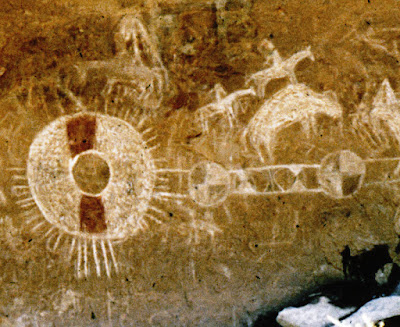Back in 1981, I ran across this representation of a blanket strip in Sego Canyon, also known as Thompson Wash, in Grand County, Utah. Someone obviously has gone to a great deal of work to leave an image of something that we normally think of as merely decorative, although decorative can be pretty special too if well done.
In the years since then I have tried to find a motive for the creation of this image. My search in ethnographic examples for some special significance of blanket strips has so far been unsuccessful. For instance, Thomas Mails, in Mystic Warriors of the Plains (1995), discussed bead work on page 290, and illustrated blanket strips on page 291, but made no reference to their significance in his text.
I did find a couple of mentions online. In one, The Wandering Bull LLC, the anonymous writer stated “The Native Americans of the Northern Plains created beaded Blanket Strips in the mid 19th century. Blanket Strips originated as a means to cover the seam where two brain-tanned buffalo hides were sown together to create one large robe. Eventually, Native American crafters began to use wool Trade Blankets for robes. They added their beaded strips to them in a purely decorative manner.” While I suppose that this is a possible explanation, the idea of two whole buffalo robes joined together for wearing strikes me as improbably large and heavy.
In 2015, Benson Lanford described a 44 inch long blanket strip created by a Plateau tribe or Crow beader. “In the mid-19th century, blanket strips became a salient decorative object type among the Plains, Plateau and some High Desert American Indian tribes. The concept of the blanket strip has origins in a relatively short, narrow band composed primarily of porcupine quillwork that covered the seam after excising the bulging hump area of a tanned buffalo hide -- excised for the purpose of flattening the hide. This decorative band of quillwork (or beadwork) was applied directly to the hide and extended for more than a third of the hide's length, from just behind the neck, down the back toward the tail. The later blanket strips, composed of tanned hide (or even canvas) were decorated and then applied to the hide robe or wool blanket. Usually, to permit ease in handling while being quilled and / or beaded, the hide strips were worked in sections--rectangles and rosettes, then sewn together once finished.” This is, to me, a somewhat more believable story for the use of a blanket strip on a single hide robe but it still provides no information of any symbolic meaning or significance.
In the Spring 2013 issue of American Indian Art magazine, Ron McCoy illustrated a Lakota blanket strip from the 19th century with the rondelles divided into quarters by slender Maltese Cross shapes which he defines as the symbol for stars. So, in that instance, the blanket strip refers to the night sky. This cannot be considered universal, however, as there are many examples of blanket strips on the internet that do not show crosses on their rondelles.
The Sego Canyon, Utah, pictograph has a large circular element on the left, surrounded by fringe, with a large, red stripe vertically through it broken by an empty circle in the center, and with each side painted a solid white. Connected to that circle on the side to our right is a sequence of a band, a rondelle, another band and a final rondelle. The rondelles are divided into painted and plain quarters, and the band between the right and center rondelles has two sets of opposed triangles painted in white. The whole is one portion of a large, complicated scene amassing horses, equestrian figures, a bison, standing humans, and a large shield on the left side of the panel. The panel sports red paint, white paint, and apparently a little black or dark for some details.
While the Sego Canyon blanket strip rondelles are divided into quarters, those quarters are not separated by a star shape so I don’t know that we can define them as referencing stars. I have come up with one possible overall implication for what a blanket strip might stand for. Based upon the definition by Benson Lawford (above) that it is used to cover the place where the robe has had a portion cut out, it might be thought to imply union, or bringing together, and thus a reference to the strength of the tribe, clan or family. Possibly, the pattern is only decorative, or the patterns may symbolize anything the artist wants it to, and the overall significance of the blanket strip is based on its very existence.
NOTE: Some images in this posting were retrieved from the internet with a search for public domain photographs. If any of these images are not intended to be public domain, I apologize, and will happily provide the picture credits if the owner will contact me with them. For further information on these reports you should read the original reports at the sites listed below.
REFERENCES:
Lanford, Benson, 2015, A Crow or Plateau Quilled and Beaded Buffalo Hide Blanket Strip, c. 1860, March 2015, https://fineart.ha.com. Accessed online 12 April 2025.
Mails, Thomas E., 1995, Mystic Warriors of the Plains, Barnes & Noble Books, New York.
McCoy, Ron, 2013, I Was Taught That the Sun Was a Great Mystery, The Sky in Lakota Art and Lore, American Indian Art Mag., Spring 2013, Vol. 38 (2), p.46-53.
The Wandering Bull LLC, https://wanderingbull.com/shop/collectibles/vintage/blanket-strip-beaded-sioux-style/. Accessed online 12 April
2025.




















